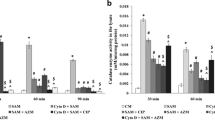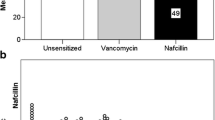Abstract
Staphylococcus aureus, including methicillin-resistant S. aureus (MRSA), produces superantigenictoxins, such as toxic shock syndrome toxin-1 (TSST-1). TSST-1 abnormally activates T cells to overproduce inflammatory cytokines (such as tumor necrosis factor-α, interleukin-2, and interferon-γ) leading to shock. In this study, we investigated the inhibitory effect of antimicrobial agents and anisodamine (a Chinese herbal extract) on TSST-1-induced cytokine production. Among the macrolides and related agents examined, azithromycin and rokitamycin showed the greatest inhibitory activity against the TSST-1-induced cytokine production. This inhibitory effect was similar to that of anisodamine, which, however, had no inhibitory activity against bacterial growth. Vancomycin, teicoplanin, arbekacin, and linezolid (anti-MRSA and related agents) had no significant inhibitory effect on cytokine production. The inhibitory effect of the drugs on cell proliferation was not significant. These data indicate that some antimicrobial agents, e.g., azithromycin and rokitamycin, manifest anti-superantigenic toxin activity through the inhibition of cytokine production, just like anisodamine.
Similar content being viewed by others
References
JK Todd (1998) ArticleTitleToxic shock syndrome Clin Microbiol Rev 1 432–46
N Takahashi H Nishida H Kato K Imanishi Y Sakata T Uchiyama (1998) ArticleTitleExanthematous disease induced by toxic shock syndrome toxin 1 in the early neonatal period Lancet 351 1614–19 Occurrence Handle10.1016/S0140-6736(97)11125-4 Occurrence Handle9620715
J Kappler B Kotzin L Herron EW Gelfand RD Bigler A Boylston et al. (1989) ArticleTitleVβ-specific stimulation of human T cells by staphylococcal toxins Science 244 811–13 Occurrence Handle2524876
H Li A Llera RA Mariuzza (1998) ArticleTitleStructure-function studies of T-cell receptor-superantigen interactions Immunol Rev 163 177–86 Occurrence Handle9700510
T Krakauer (1999) ArticleTitleImmune response to staphylococcal superantigens Immunol Res 20 163–73 Occurrence Handle10580640
T Ohara S Kojio I Taneike S Nakagawa F Gondaira Y Tamura et al. (2002) ArticleTitleEffects of azithromycin on shiga toxin production by Escherichia coli and subsequent host inflammatory response Antimicrob Agents Chemother 46 3478–83 Occurrence Handle10.1128/AAC.46.11.3478-3483.2002 Occurrence Handle12384353
RJ Xiu DE Hammerschmidt PA Coppo HS Jacob (1982) ArticleTitleAnisodamine inhibits thromboxane synthesis, granulocyte aggregation, and platelet aggregation. A possible mechanism for its efficacy in bacteremic shock JAMA 247 1458–60 Occurrence Handle10.1001/jama.247.10.1458 Occurrence Handle7057538
HM Zhang ZL Ou F Gondaira M Ohmura S Kojio T Yamamoto (2001) ArticleTitleProtective effect of anisodamine against Shiga toxin-1: inhibition of cytokine production and increase in the survival of mice J Lab Clin Med 137 93–100 Occurrence Handle10.1067/mlc.2001.112507 Occurrence Handle11174465
HM Zhang ZL Ou T Yamamoto (2001) ArticleTitleAnisodamine inhibits shiga toxin type 2-mediated tumor necrosis factor-alpha production in vitro and in vivo Exp Biol Med 226 597–604
RJ Xiu (1980) ArticleTitleStudies on microcirculation in institute of basic medical sciences Microvasc Res 20 371–3 Occurrence Handle10.1016/0026-2862(80)90065-5 Occurrence Handle7207228
K Imanishi K Seo H Kato T Miyoshi-Akiyama RH Zhang Y Takanashi et al. (1998) ArticleTitlePost-thymic maturation of migrating human thymic single-positive T cells: thymic CD1a− CD4+ T cells are more susceptible to anergy induction by toxic shock syndrome toxin-1 than cord blood CD4+ T cells J Immunol 160 112–19 Occurrence Handle9551963
T Krakauer (1995) ArticleTitleInhibition of toxic shock syndrome toxin-1-induced cytokine production and T cell activation by interleukin-10, interleukin-4, and dexamethasone J Infect Dis 172 988–92 Occurrence Handle7561220
RP Gladue ME Snider (1990) ArticleTitleIntracellular accumulation of azithromycin by cultured human fibroblasts Antimicrob Agents Chemother 34 1056–60 Occurrence Handle2168141
JE Conte SuffixJr J Golden S Duncan E McKenna E Lin E Zurlinden (1996) ArticleTitleSingle-dose intrapulmonary pharmacokinetics of azithromycin, clarithromycin, ciprofloxacin, and cefuroxime in volunteer subjects Antimicrob Agents Chemother 40 1617–22 Occurrence Handle8807050
AA Khan TR Slifer FG Araujo JS Remington (1999) ArticleTitleEffect of clarithromycin and azithromycin on production of cytokines by human monocytes Int J Antimicrob Agents 11 121–32
D Torre M Broggini S Rossi C Sampietro V Botta (1989) ArticleTitleEffect of rokitamycin on human polymorphonuclear leukocyte chemotaxis Int J Tissue React 11 27–9 Occurrence Handle2807774
Author information
Authors and Affiliations
Corresponding author
About this article
Cite this article
Kushiya, K., Nakagawa, S., Taneike, I. et al. Inhibitory effect of antimicrobial agents and anisodamine on the staphylococcal superantigenic toxin-induced overproduction of proinflammatory cytokines by human peripheral blood mononuclear cells. J Infect Chemother 11, 192–195 (2005). https://doi.org/10.1007/s10156-005-0389-8
Received:
Accepted:
Issue Date:
DOI: https://doi.org/10.1007/s10156-005-0389-8




